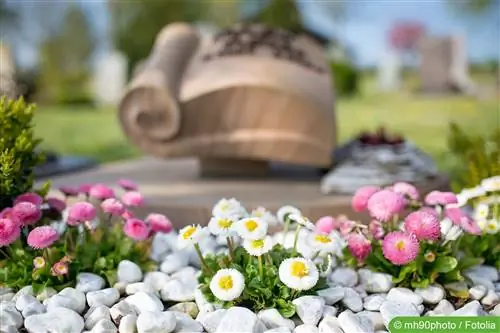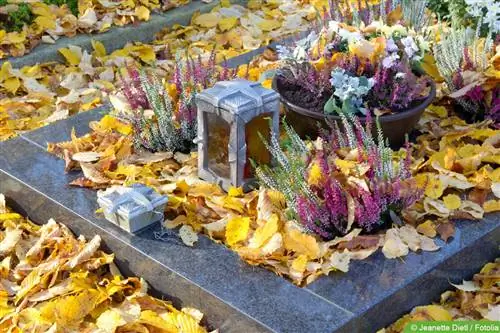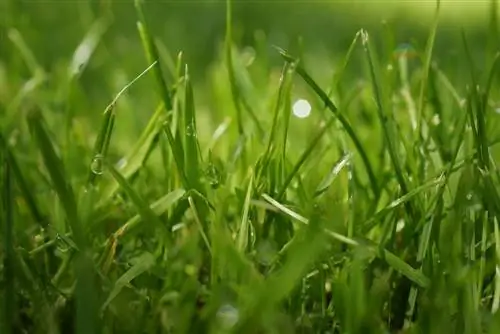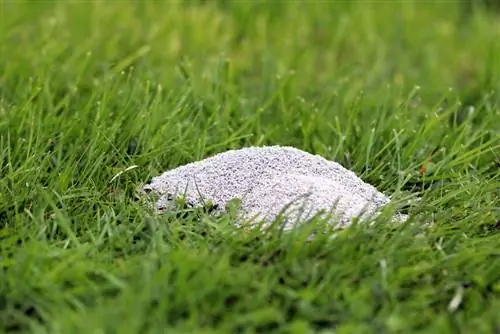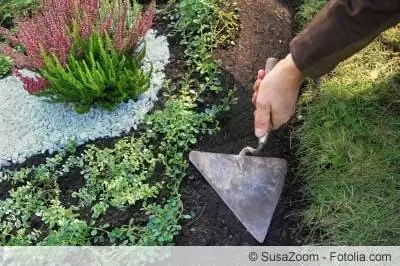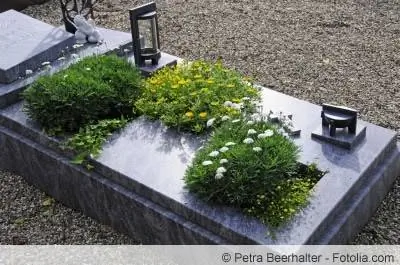- Author admin [email protected].
- Public 2023-12-17 03:39.
- Last modified 2025-01-24 12:45.
Spring is the best time to replant a grave. If a few simple rules are followed, the grave is very easy to care for all year round. Finding appropriate planting is not difficult at all. In spring, early flowering plants such as flower bulbs, which were planted in the ground the previous year, are used. You can find out here which plants are suitable for planting graves in spring. If you would like to completely redesign the grave, you will also find some ideas for cemetery planting.
Arrangement and division of the planting
The grave planting can be varied throughout the year without much effort if a good basis is created. This consists of a few shrubs that create a transition to the gravestone, as well as perennial ground cover. The remaining space is beautified with flowering plants or decorative items. Before designing, you should always study the cemetery regulations to find out whether one or the other plan might be undesirable. The grave looks more attractive if not only individual plants are placed and the earth is exposed in between. An arrangement in horizontal and vertical rows usually seems too strict. Guidelines for the use of different plants and the division of the grave area:
1. Single grave
- Frame plants: 25%
- Ground cover: 50%
- Alternate planting: 35%
2. Double grave
- Frame plants: 25%
- Ground cover: 60%
- Alternate planting: 15%
Tip:
To loosen up the look, the plants should always be arranged in smaller groups, similar to a perennial bed. Curved lines (such as half or quarter circles, wavy lines and slight arcs) appear playful. Asymmetrical arrangements visually enlarge the grave.
Alternate planting in spring
An area of the grave is planned with seasonally changing planting. In spring, flower bulbs are mainly used here, which are either planted in autumn or alternatively can be grown or purchased as potted plants. Flower bulbs look really beautiful in smaller groups, possibly in a coordinated color. They bathe the grave in bright colors as early as February or March, when the rest of the plant life is still in hibernation.
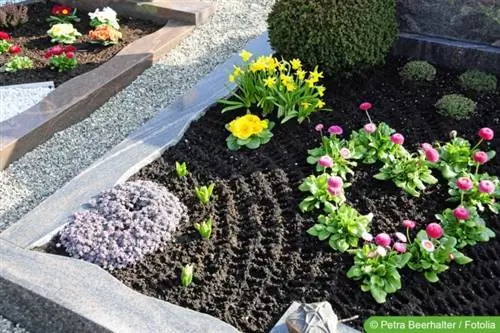
Bloom in February and March
- Christmas Rose
- Snowdrops
- crocus
- horn violets
- Pansies
- Spring Anemone
Flowering in April and May
- Carpet phlox (Phlox subulata)
- Scented Violet (Viola odorata)
- Memorial (Omphalodes verna)
- Goose cress (Arabis caucasia or arendsii)
- Garden Carpet Primrose (Primula pruhoniciana)
- Forget-me-not (Myosotis)
- Daffodils (Narcissus)
- Tulips (Tulipa)
- Hyacinths (Hyacinthus)
- Phlox
Tip:
If you use flower bulbs, you should ensure there is sufficient moisture around the bulbs so that their roots can develop well.
Frame plants
In order to create a soft, flowing transition between the flat grave surface and the gravestone, low trees or bushes that also grow slowly are suitable. A combination of deciduous trees and conifers looks particularly pretty in just one back corner of a double grave. In the case of individual graves, there is usually only enough space for a single tree.
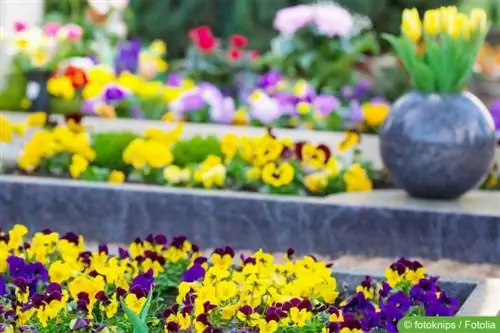
Suitable frame plants:
- Juniper
- Tree of Life
- Cypresses, mussel cypresses
- Boxwood
- small maple species
- Judas tree
- Rhododendrons and azaleas
- Roses
Tip:
The plants mentioned are evergreen except for the roses and are a wonderful decoration for the grave in summer and winter. They also grow quite slowly and therefore require little work.
Groundcover
When designing graves in spring, ground cover plants are always recommended as part of the planting. Not only do they prevent uncontrolled weed growth, but they also shade the ground during warmer days so that there is less moisture loss. The ground-covering plants also form a pretty frame for the flowering plants. Ground cover plants can be used to create beautiful shapes on the grave area. Evergreen ground cover plants that grow very low above the ground are particularly suitable for grave planting. Many of these plants not only decorate the grave all year round with their foliage, but also develop white or colorful berries in late summer.
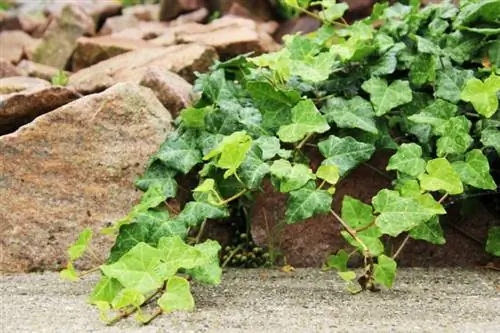
The following ground cover plants are ideal forcemetery planting in spring:
- Ivy (Hedera helix)
- Creeping spindle (Eonymus fortunei)
- Periwinkle (Vinca minor)
- Cushion thyme
- Hazelroot (Asarum europaeum): shade tolerant
- Golden strawberry (Waldsteinia): shade tolerant
- Partridgeberry (Mitchella repens)
- Cat's paws (Antennaria): for dry, sandy soils
- Hungry flower (Draba verna)
- St. John's wort (Hypericum calycinum): drought-resistant
- Purple bells (Heuchera): varieties for full sun or shade
- Carpet cotoneaster (Cotoneaster dammeri radicans)
- Fat male (Pachysandra terminalis): also for shady places
- Shadow bell (Pieris japonica)
- Spring cinquefoil (Potentilla neumanniana): drought-resistant
Good combinations for grave planting
In the background on the right or left one or two (in the case of a double grave) arborvitae, cypresses or box trees. The rest of the grave is divided into areas and provided with ground cover and alternate planting. If parts of the grave are not to be planted, the ground is covered with bark mulch or gravel. If necessary, a stone slab can be laid out in the front area so that a grave light or a wreath can be placed there later.
Ideas for single graves
Combination of triangles
Draw a triangle almost the entire length of the grave with the point facing forward. In the middle, the triangle is interrupted by a strip (vertical) about 20-30 centimeters wide.
- Frame plant: Boxwood (Buxus) at the back left
- Ground cover: Creeping spindle (Eonymus fortunei), variant Emerald Gaiety for the triangle on the right and left, variant Minimus for the middle
- alternating planting: large-flowered pansies
Soft waves
In front of the frame plants, the grave area is divided into two parts, wave-shaped from front to back to the gravestone.
- Frame plants: Mussel cypress (Chamaecyparis obtusa), in front of it blue creeping juniper (Juniperus squamata) at the back left
- Ground cover: small specimen of blue creeping juniper on the front right, cushion thyme on the left (mostly blooms violet)
- Alternate planting: white tulips in combination with white carpet phlox
Combination for sandy, nutrient-poor soils
Aral into thirds, quarter circles and wavy lines from ground cover and alternate planting. The alternating planting goes in the middle, the ground cover to the right and left.
- Frame plant: Judas tree (Cercis canadensis)
- Ground cover: Cat's paw (Antennaria carpatica) and cushion thyme
- alternating planting: white, double daffodils
Mixture with roses
One or two frame plants are placed in the back right. In the quarter circle below and in front of it there are ground cover plants. Create a quarter circle of ground cover plants on the front right. Place 2-3 roses in the area between them. The remaining vacant spaces will be filled with seasonal plants.
- Frame plant: Mussel cypress
- Ground cover: White-colored creeping spindle (Eonymus fortunei, variant Emerald Gaiety), ground cover roses
- Alternate planting: Blue cushions (Aubrieta), crocuses or daffodils fit in between
Ideas for double graves
Diagonal division with circular area
Under the frame plants (back right), the grave is planted extensively with ground cover plants. In the front right area, a circle of around 60-80 centimeters in size is left out into which the alternating planting is inserted. Two different ground cover plants are used, which divide the grave diagonally in an arch or wave shape (back left to front right). Instead of the simple circle, a yin-yang symbol or other images can be created using different colors.
- Frame plant: Japanese maple
- Ground cover: Cotoneaster (Cotoneaster dammeri) and creeping spindle (Euonymus fortunei)
- Alternate planting: Horned violets
Horizontal wavy division
Slightly behind half of the area, a wavy strip about 30 centimeters wide is created from right to left for alternating planting. Various ground cover plants come to the front and back.
- Frame plant: Ilex (possibly in topiary)
- Ground cover: Periwinkle (Vinca minor) in the back and foliage (Draba verna) in the front
- Alternative planting: Crocuses, then white, purple or blue pansies
Strictly geometric shapes
The area is divided into three parts (from front to back). The left area should be a little larger than the other two. The alternating planting is placed a little further forward than in the middle on the left and middle fields. A heart shape or teardrop shape about 60-80 centimeters in size works well for alternating planting.
- Frame plants: Mussel cypress (Chamaecyparis obtusa), diagonally in front of it Blue creeping juniper (Juniperus squamata)
- Ground cover: Cotoneaster dammeri variant Frieder`s Evergreen (middle), right and left Eonymus fortunei variant Emerald Gaiety
- Alternative planting: initially tulips, later horned violets
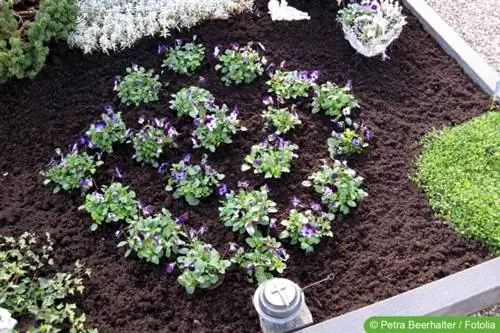
Light conditions and soil conditions
So that the grave planting can thrive and remain beautiful for a long time, it is very important to pay attention to the external conditions. In addition to the lighting conditions, the condition of the soil is also of crucial importance for planting. Plants should be selected based on site conditions.
Tip:
In spring, some fertilizer should be applied in the form of compost or slow-release fertilizer (horn shavings, blue grain).
Conclusion
When planting graves in spring, flower bulbs in combination with early-flowering perennials (flowering plants) form an ideal combination. As the onion plants fade, the spring bloomers grow and over time cover the dying leaves of the onion plants. This is how the grave looks well maintained throughout.

